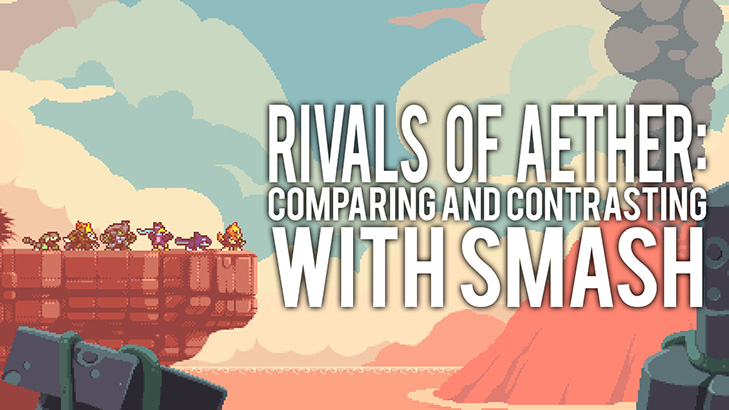Rivals of Aether is finally out of Early Access and into its full release. While the game has many of the core aspects of Smash, it features a few key differences. We're here to break down everything you need to know going into the game.
New Stages, Story Mode, and Features galore
Several new stages have been added to the roster. These include a Final Destination-esque stage, stages for Etalus and Absa, and a story based on the character select screen's background.
A story mode has also been introduced, with a unique story for each of the six default characters. It plays much like Super Smash Bros' classic mode, albeit somewhat more basic, with short scenes between each fight. Once each character's story is completed, players face off against a final boss with their character of choice. Upon beating the final boss, the credits roll, and the player is dropped straight into Abyss mode. Story mode also features a leaderboard system documenting the time for each player's shortest run through a character's story.
Another major addition to Rivals is the introduction of Abyss mode. Combining the horde modes seen in many shooters with the single-player minigames seen in Super Smash Bros., Abyss mode has players fight through waves of increasingly difficult challenges, each with their own goals and obstacles. One wave may throw a horde of weak opponents at the player, another might force the player to traverse a series of moving platforms without touching the floor, while yet another may force them to contend with a wave of enemies who explode when hit. Abyss mode also features a leveling system where players gain equipment slots for each character. These slots are used to equip runes that alter a character's attributes in some way. Players can also use these runes in a standard versus match through Abyss Versus mode.
Though it isn't new to the full release, an online Team Match mode was introduced near the end of Early Access. Two players on a shared setup can team up against other teams of two, either in matchmaking or with friends through Steam.
Plenty of other features have been introduced in the jump to full release, some of which I'm sure even I haven't found out about. Dan Fornace and his team have introduced plenty of unlockable content, including alternate costumes and stages. Future patches have also been announced, including some hints at future DLC characters. They also plan on continuing to support the community through events like CEO Dreamland, as well as a second season of the Rivals Championship Series.

A Simple Yet Fast-Paced Core
Most fighting games have a sort of rock-paper-scissors dynamic at play. Blocking beats attacking, attacking beats grabbing, and grabbing beats blocking. Rivals, on the other hand, lacks blocking and grabbing mechanics, so emphasis is instead placed on another more abstract and oft-overlooked dynamic, one based around pokes, whiff punishing, and moving forward. Pokes stuff up attempts to move forward, whiff punishing takes advantage of failed attempts to poke, and moving forward leaves the opponent with nothing to whiff punish.The end result of this is somewhat similar to Nidhogg and Divekick, with a heavy emphasis placed on basic footsies and mindgames. Rivals has very little in the way of crutch options for players to rely on in low-level play, and high-level play tends to be fast and frenetic, much like Super Smash Bros. Melee or Project M. While not as extreme as Nidhogg and Divekick's one-hit kills, Rivals presents a very high potential reward for those who can successfully read their opponent, with a combo system highly reminiscent of Melee.
The read-based gameplay is also emphasized through the game's parry system. Much like Soul Calibur's Guard Impact mechanic, Guilty Gear Xrd's Blitz Shield, parries in Rivals function as a counter-attack. If the player successfully parries an attack, their opponent is briefly stunned, giving the player the opportunity to start a high-damage combo or convert into an easy kill. If the player fails, they're instead left vulnerable, and the opponent has the opportunity to start a combo or land a kill move of their own.
Rivals also does away with ledge grabbing, forcing players to land on the stage itself. To compensate, every character can wall-jump, even when in free-fall, and many characters have recovery tools that are stronger than anything in Smash, from teleports to a set point to summoning huge pillars to stand on. At the same time, these tools are often harder to use effectively, with many either leaving the user vulnerable or requiring prior setup to use.
Creative and Complex Characters
While Rivals' core gameplay is relatively simple, its cast can be anything but. Every character has a unique mechanic that affects their overall playstyle, allowing them to alter the stage, their opponents, or even themselves in ways you would never see in Smash. This facilitates a degree of control over the stage and the pace of the match not seen in other games.Just looking at half of the game's cast, you can see how varied everyone is. Zetterburn, the game's resident space animal clone, sets opponents ablaze with his special attacks and back-air, damaging them over time and bolstering the kill power of his smash attacks. Wrastor's side-special leaves behind a trail of wind that boosts his speed both on the ground and in the air. Kragg, one of the game's two heavy characters, can pull a rock from the ground and throw it like an item, use it as a small wall or platform, and even break it to send gravel flying at the opponent. The game's de facto mascot, Orcane fires drops of water that leave behind puddles when they hit the ground. He can then teleport to the puddle from anywhere on the screen, make it explode into a pillar of bubbles, or absorb it to increase the range and kill potential of his smash attacks.
That's just four of the game's eight characters. Of the other four, Forsburn, who covers the screen in smoke and sends out decoys, and Maypul, a speedy rushdown character who can ensnare opponents, are available right from the start. The other two, Absa and Etalus, must be unlocked by spending in-game coins that are earned through gameplay.
Overall, an Interesting Twist on the Smash Formula
Rivals of Aether is definitely not for everyone, but whether you like Melee's fast pace and high skill ceiling or Brawl and Smash Wii U's accessibility and creative character design, it's worth giving a shot. The update has definitely shown how much work the developers have put into the game. Dan Fornace himself has commented about how much he truly cares about the scene, and it's clear that he won't stop supporting it any time soon.You can check out Rivals of Aether on Steam.
Last edited by a moderator:


